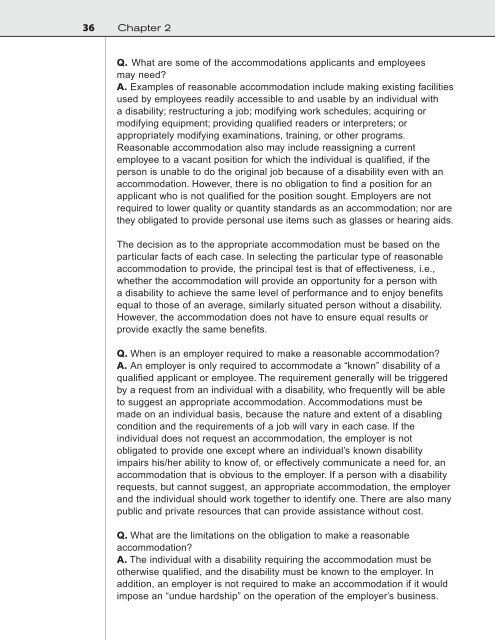Design for Accessibility: A Cultural Administrator's Handbook
Design for Accessibility: A Cultural Administrator's Handbook
Design for Accessibility: A Cultural Administrator's Handbook
You also want an ePaper? Increase the reach of your titles
YUMPU automatically turns print PDFs into web optimized ePapers that Google loves.
36 Chapter 2<br />
Q. What are some of the accommodations applicants and employees<br />
may need?<br />
A. Examples of reasonable accommodation include making existing facilities<br />
used by employees readily accessible to and usable by an individual with<br />
a disability; restructuring a job; modifying work schedules; acquiring or<br />
modifying equipment; providing qualified readers or interpreters; or<br />
appropriately modifying examinations, training, or other programs.<br />
Reasonable accommodation also may include reassigning a current<br />
employee to a vacant position <strong>for</strong> which the individual is qualified, if the<br />
person is unable to do the original job because of a disability even with an<br />
accommodation. However, there is no obligation to find a position <strong>for</strong> an<br />
applicant who is not qualified <strong>for</strong> the position sought. Employers are not<br />
required to lower quality or quantity standards as an accommodation; nor are<br />
they obligated to provide personal use items such as glasses or hearing aids.<br />
The decision as to the appropriate accommodation must be based on the<br />
particular facts of each case. In selecting the particular type of reasonable<br />
accommodation to provide, the principal test is that of effectiveness, i.e.,<br />
whether the accommodation will provide an opportunity <strong>for</strong> a person with<br />
a disability to achieve the same level of per<strong>for</strong>mance and to enjoy benefits<br />
equal to those of an average, similarly situated person without a disability.<br />
However, the accommodation does not have to ensure equal results or<br />
provide exactly the same benefits.<br />
Q. When is an employer required to make a reasonable accommodation?<br />
A. An employer is only required to accommodate a “known” disability of a<br />
qualified applicant or employee. The requirement generally will be triggered<br />
by a request from an individual with a disability, who frequently will be able<br />
to suggest an appropriate accommodation. Accommodations must be<br />
made on an individual basis, because the nature and extent of a disabling<br />
condition and the requirements of a job will vary in each case. If the<br />
individual does not request an accommodation, the employer is not<br />
obligated to provide one except where an individual’s known disability<br />
impairs his/her ability to know of, or effectively communicate a need <strong>for</strong>, an<br />
accommodation that is obvious to the employer. If a person with a disability<br />
requests, but cannot suggest, an appropriate accommodation, the employer<br />
and the individual should work together to identify one. There are also many<br />
public and private resources that can provide assistance without cost.<br />
Q. What are the limitations on the obligation to make a reasonable<br />
accommodation?<br />
A. The individual with a disability requiring the accommodation must be<br />
otherwise qualified, and the disability must be known to the employer. In<br />
addition, an employer is not required to make an accommodation if it would<br />
impose an “undue hardship” on the operation of the employer’s business.


